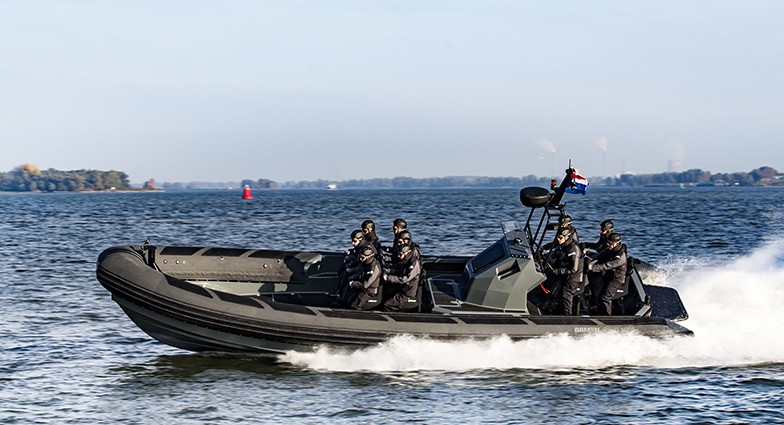- The deck is as low as possible to improve the centre of gravity while enhancing weather protection.
- Like any good offshore RIB, the sponsons are raised at the bow.
- Impressive though the hull is, inboard the boat is where Damen’s design excels.
Greg Copp lifts the lid on a new multi-purpose craft from the Damen stable that touches the very heart of purist RIB design …
The RHIB 1050 created by Damen Shipyards of Holland for use by special forces and naval search teams is a 55-knot 10.5m RIB powered by twin 370hp Volvo D6s that has been built with a zero compromise approach. Based on a sharp deep-vee hull, ‘it is not your average RIB’, as Roel Foolen of Damen Shipyards put it.
The Lloyd’s-approved hull is built with an epoxy composite as opposed to conventional polyester. Strengthening is further enhanced by a closed-cell foam core, which is much stronger than conventional foam cores. Closed-cell foam will not absorb water in the event of hull damage, and by its nature does allow any resin penetration during lay-up, thereby increasing laminate strength in the process. However, it does require a lot more crafting in the construction process, as heat is often needed to shape it. As is often the case with military/commercial craft, Damen have chosen not to step the hull, the only embellishment below the waterline being three substantial full-length spray rails.
Impressive though the hull is, inboard the boat is where Damen’s design excels. Ergonomics have been closely focused upon, in particular the console. The first prototype had a mock-up console that was tweaked and modified in line with feedback from sea trials, until the perfect match was achieved for the helmsman. To keep everything functioning and effective in the worst weather conditions, the console instrumentation is housed within a watertight heated compartment viewed through a window that will never mist up. The electrics are likewise enclosed in a watertight heated chamber to prevent any potential moisture issues – so no plotter or radio failures if the boat gets swamped or capsized. And smaller details do not go unnoticed, such as incorporating lifting eyes into the boat’s bollards so there are no trip hazards.
What is particularly different about the RHIB design is that the engine is housed under the console instead of in an engine bay at the stern. The concept is brilliant as its gets the 1300kg of the combined weight of two D6 engine blocks 2 metres forward of the transom, leaving just 200kg of sterndrive weight at the stern. This hugely benefits hull efficiency as well as improving fore and aft trim, not to mention enabling the boat to maintain low planing speeds when sea conditions dictate. It does however require two extended driveshafts to connect the engines with the sterndrives. Engine access is obtained by the complete console hinging aft, enabling service teams to gain easy access to uncluttered engines. For stowage on board a mother ship, the console-mounted radar mast also hinges back. The two 350L fuel tanks are located beneath the seating fore and aft of the console; in the case of the aft tank it lies above the driveshafts. To enable easy access to these tanks, the deck sections to which the seats are mounted are in effect large watertight hatches that lift away – a sensible feature for a boat that may well have to operate in parts of the world where fuel quality is questionable.
The 10 suspension seats that accommodate the crew are Ullmans – arguably the best seats in the business for keeping your spine intact, which at £1,500 each they should be. The heavy-duty armoured Hypalon sponsons are bolted to the hull via aluminium sealing strips as opposed to conventional adhesive bonding. Consequently they are far less likely to part company with the hull when running into big head seas. Like any good offshore RIB, the sponsons are raised at the bow. Unusually they take on an asymmetrical D-shape profile from the console to the stern. This is to make movement past the console easy, as symmetrical sponsons rob the boat of that crucial aft inboard crew space. The deck is as low as possible to improve the centre of gravity while enhancing weather protection. Mounted on the transom is a diving platform that serves to protect the sterndrives when boarding other vessels stern-to.
Damen intend to build further versions of the RH1B 1050, based on the same hull platform, which will be fitted with two 400hp outboards. The only production 400hp outboard at the moment is the recently released supercharged 400hp Mercury Verado built for race use, but the unburstable Yamaha F350 is another possible option. However, when you consider the 1300ft/lb of combined torque produced by two 370hp Volvo D6s, the Verados, supercharged or not, will fall short of matching the D6s.
Production is based at Damen’s specialist composite yard in Antalya in Turkey, so we can only hope it is not long before we see a commercial version operating off our shores at some point.
Contact














